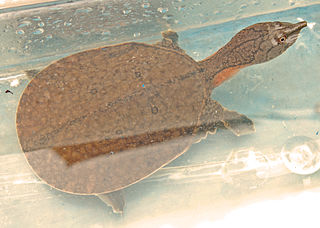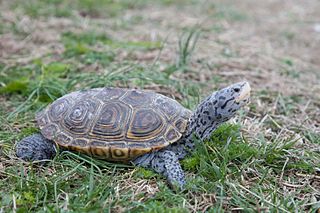Related Research Articles

Jamaica Bay Wildlife Refuge is a wildlife refuge in New York City managed by the National Park Service as part of Gateway National Recreation Area. It is composed of the open water and intertidal salt marshes of Jamaica Bay. It lies entirely within the boundaries of New York City, divided between the boroughs of Brooklyn to the west and Queens to the east.

The Bolson tortoise, also called the Mexican giant tortoise or yellow-margined tortoise, is a species of tortoise from North America. Of the six North American tortoise species, it is the largest, having a carapace length of about 46 cm (18 in). It lives in a region of the Chihuahuan Desert known as the Bolsón de Mapimí, which is located in north-central Mexico.

The Arakan forest turtle is a critically endangered turtle species native to the Arakan Hills in western Myanmar and the bordering Chittagong Hill Tracts in Bangladesh. The Arakan forest turtle is a semiterrestrial turtle, meaning it can survive in aquatic as well as terrestrial habitats, but adults prefer living in terrestrial habitats.

Heosemys is a genus of freshwater turtles in the family Geoemydidae. The genus Heosemys was split out of the related genus Geoemyda by McDowell in 1964.

The giant Asian pond turtle inhabits rivers, streams, marshes, and rice paddies from estuarine lowlands to moderate altitudes throughout Cambodia and Vietnam and in parts of Laos, Malaysia, Myanmar and Thailand.

The northern river terrapin is a species of riverine turtle native to Southeast Asia. It is classified Critically Endangered by the IUCN and considered extinct in much of its former range.

The impressed tortoise occurs in mountainous forest areas in Southeast Asia, mainly in Myanmar Burma, southern China, Thailand, Laos, Vietnam, Cambodia, Malaysia and Northeast India. The species has a golden brown shell and skin. Adults are much smaller than their relatives the Asian forest tortoise, with a maximum carapace length of 35 cm (14 in).

The Malayan softshell turtle is a species of softshell turtle in the family Trionychidae. It is monotypic in its genus.

The painted terrapin, painted batagur, or saw-jawed turtle is a species of turtles in the family Geoemydidae. It was formerly in its own genus, Callagur, but has been reclassified to the genus, Batagur.
The variable mud turtle, also known as Rhodesian mud turtle, Mashona hinged terrapin or variable hinged terrapin, is a species of turtle in the family Pelomedusidae. It is widely distributed in Central, East, and Southern Africa. The species was officially described by John Hewitt in 1927 and had to be broken into subspecies due to color variations on the heads of the turtles acrost the regions.

Siebenrockiella crassicollis is a freshwater turtle endemic to Southeast Asia. It is one of two species classified under the genus Siebenrockiella in the family Geoemydidae.

Terrapins are one of several small species of turtle living in fresh or brackish water. Terrapins do not form a taxonomic unit and may not be closely related. Many belong to the families Geoemydidae and Emydidae.

Dr. Chan Eng Heng, a retired professor from Universiti Malaysia Terengganu, is a turtle conservationist who has been recognised by the United Nations Environment Program for her efforts to protect sea turtles.
Rakhine Yoma Elephant Range is a protected area in Myanmar's Rakhine Yoma mountains, covering about 1,756 km2 (678 sq mi) of evergreen and mixed deciduous forest at an elevation of 20–1,270 m (66–4,167 ft).

Batagur is a genus of large turtles from South and Southeast Asia. All members of the genus are seriously threatened. With a recent merger with members from two other genera, this genus has six described species.

The southern river terrapin is a turtle of the family Geoemydidae found in Malaysia, Indonesia and Cambodia.
Minsontaung Wildlife Sanctuary is a protected area in Myanmar, covering 22.56 km2 (8.71 sq mi). It was established in 2001. It ranges in elevation from 195 to 375 m in the Natogyi Township, Mandalay Region.

The Turtle Conservancy (TC) is a 501(c)3 organization with a focus on protecting threatened turtles and tortoises and their habitats worldwide working toward improving turtle and tortoise populations in the wild. The TC is a conservation organization protecting tortoises and freshwater turtles with work in five areas: species conservation, protection of wild lands, research science, global awareness and education, and illegal trade prevention.

Centrochelys is a genus of tortoise. It contains one extant species and several extinct species:
References
- 1 2 3 4 5 6 7 "Kalyar Platt – Saving Imperiled Turtles in Myanmar". Turtle Survival Magazine. December 2015. pp. 64–65.
- 1 2 3 4 5 6 "Explorer Directory: Kalyar Platt". National Geographic Society. Retrieved 11 December 2022.
- ↑ Aung, Thu Thu (4 December 2020). "Myanmar monk offers temple sanctuary for threatened snakes". Reuters.
- ↑ "Woman in conservation interview: Kalyar Platt, Turtle Survival Alliance". Asian Species Action Partnership. 27 April 2021.
- ↑ Tu-Maung, Nicole (18 August 2019). "Conserving wildlife, preserving traditions". Frontier Myanmar.
- ↑ Platt, Steven G.; Myo, Khin Myo; Ko, Win Ko; Maung, Aung; Rainwater, Thomas R. (June 2010). "Field Observations and Conservation of Heosemys depressa in the Rakhine Yoma Elephant Range of Western Myanmar". Chelonian Conservation and Biology. 9 (1): 114–119. doi:10.2744/CCB-0813.1. S2CID 86775422.
- ↑ "Arakan mountain tortoises face extinction in next decade: conservation group". Burma News International. 14 September 2021.
- ↑ Yin, Steph (4 October 2017). "Slow and Steady, a Tortoise Is Winning Its Race With Extinction". The New York Times.
- ↑ Klein, Alice (16 June 2017). "My patrol with armed guards to protect Burmese star tortoises". New Scientist.
- ↑ Phyo Wai Kyaw (17 July 2018). "Population of rare star tortoises rises to 15,000". The Myanmar Times.
- ↑ "World's second most endangered turtle on road to recovery". ScienceDaily. Wildlife Conservation Society. 10 April 2015.
- ↑ Poole, Colin (July 2018). "The Wildlife Conservation Society". Globerovers Magazine. p. 80.
- ↑ Wong, Ramacandra (23 August 2015). "Kalyar Platt receives the 10th Annual Behler Turtle Conservation Award". WCS Myanmar News (in Burmese). Wildlife Conservation Society.
- ↑ Platt, Kalyar; Platt, Steven G.; Thirakhupt, Kumthorn; Rainwater, Thomas R. (December 2008). "Recent Records and Conservation Status of the Critically Endangered Mangrove Terrapin, Batagur baska, in Myanmar". Chelonian Conservation and Biology. 7 (2): 261–265. doi:10.2744/CCB-0701.1. S2CID 84454944.
- ↑ "Freeing turtles into pagoda ponds does more harm than good". The Myanmar Times. 30 May 2019.
The pond is small and the number of turtles is huge. People capture the turtles which are living freely in their natural environment and sell them to pilgrims to release into the ponds for good merit. How would one feel if they were forced to live in such cramped conditions?